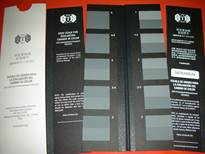Purpose of Test
This colorfastness to light test is designed to determine how well a material will retain its color under various light exposures. The test provides the principles and procedures that make it possible to evaluate colorfastness under different conditions.
This test method was designed for textiles made with various kinds of colorants, treatments, and finishes.
There are six different options in this test method:
- Enclosed Carbon-Arc Lamp, Continuous Light
- Enclosed Carbon-Arc Lamp, Alternate Light and Dark
- Xenon-Arc Lamp, Continuous light, Black Panel Option
- Xenon-Arc Lamp, Alternate Light and Dark
- Xenon-Arc Lamp, Continuous Light, Black Standard Option
- Daylight Behind Glass
Terminology Defined
Colorfastness – Colorfastness is a fabric’s ability to retain color in various conditions.
Fadometer – A test instrument that measures fabric resistance to fading.
Accelerated Fading Units (AFU) – An energy unit used in AATCC test methods. It is equivalent to 1/20 of required exposure energy to make a fabric reference fade up to a certain grade in the AATCC Gray Scale.
Enclosed Carbon-Arc Lamp – One of the light sources used in the test methods. It is a light enclosed in a borosilicate glass that filters low-wavelength radiation.
Xenon-Arc Lamp – An electric light produced at high pressure by passing electricity through ionized gas.
Daylight Behind Glass – Natural light that is transmitted through glass.
Gray Scale for Color Change – The scale used in measuring the color changes of textiles after undergoing colorfastness tests.

Test Method
Materials Used for Test
- Test specimen
- Light source
- Fadometer
- AATCC Gray Scale for Color Change
Testing Procedure
The different test methods determine fabric performance under standard laboratory conditions. The test varies per light source. A strip of test specimen is exposed to the light source for 40 hours and evaluated by using the AATCC Gray Scale for Color Change
Test Procedure (Summary)
Part 1: Determination of what test method to use: All tests determine fabric colorfastness to light. However, the tests differ according to what type of light source is to use in the assessment.
Part 2: Testing of the test specimen: Once the test option is confirmed, a strip of the test specimen is placed in a fadometer and left exposed for 40 hours of accelerated fading units (AFU).
Part 3: Assessment of colorfastness: Upon completion of the exposure period, the color difference of the exposed and protected parts of the fabric are compared to the AATCC Gray Scale for Color Change. The degree of fading is evaluated with these ratings:
- Grade 5 – No fading
- Grade 4 – Slight fading
- Grade 1 – High degree of fading